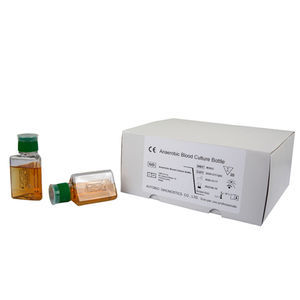
- Laboratory
- Laboratory medicine
- Antimicrobial susceptibility test kit
- Autobio Diagnostics

- Company
- Products
- Catalogs
- News & Trends
- Exhibitions
Antimicrobial susceptibility test kit MD0101for ASTbacteriaclinical
Add to favorites
Compare this product
Characteristics
- Application field
- for antimicrobial susceptibility
- Tested parameter
- for AST
- Micro-organism
- bacteria
- Sample type
- clinical
Description
The primary objective of susceptibility testing in clinic is to predict the treatment effect of an infected individual with chosen antimicrobial agents. Results must be derived in a timely manner with a high degree of accuracy and reproducibility. Antimicrobial susceptibility testing (AST) is usually carried out to determine which antimicrobial agent will be most successful in treating a bacterial infection in vivo. Clinical laboratories can choose to determine the susceptibility of bacteria by a number of methods mainly including disc diffusion, dilution (broth microdilution method, broth microdilution method and agar dilution), serial dilution (E-test) minimum inhibitory concentration (MIC) determination1,2, of which can be performed manually or automatically.
Clinical Application
The MIC of an organism is defined as the minimum amount of antimicrobial agent required to inhibit the growth of the test organism over a specified time interval (which is related to the growth rate of the bacteria). The rapid and accurate determination of the MIC value for an antimicrobial agent/organism combination can significantly improve patient management and prognosis since it enables the prompt administration of appropriate antimicrobial agent therapy.
Authoritative Results
The Interpretive Categorical Results (SIR) should be interpreted by referring to the latest MIC breakpoint interpretation standard published by CLSI 3 or EUCAST 4
Catalogs
No catalogs are available for this product.
See all of Autobio Diagnostics‘s catalogsExhibitions
Meet this supplier at the following exhibition(s):

Related Searches
- Assay kit
- Solution reagent kit
- Blood assay kit
- Serum assay kit
- Plasma assay kit
- Infectious disease detection kit
- Diagnostic reagent kit
- Respiratory infection test kit
- Clinical assay kit
- COVID-19 assay kit
- Bacteria reagent kit
- Antigen assay kit
- IgG test kit
- Clinical reagent kit
- Laboratory detection kit
- Cell assay kit
- Microbiology reagent kit
- Oncology test kit
- Urine assay kit
- Lyophilized reagent kit
*Prices are pre-tax. They exclude delivery charges and customs duties and do not include additional charges for installation or activation options. Prices are indicative only and may vary by country, with changes to the cost of raw materials and exchange rates.







